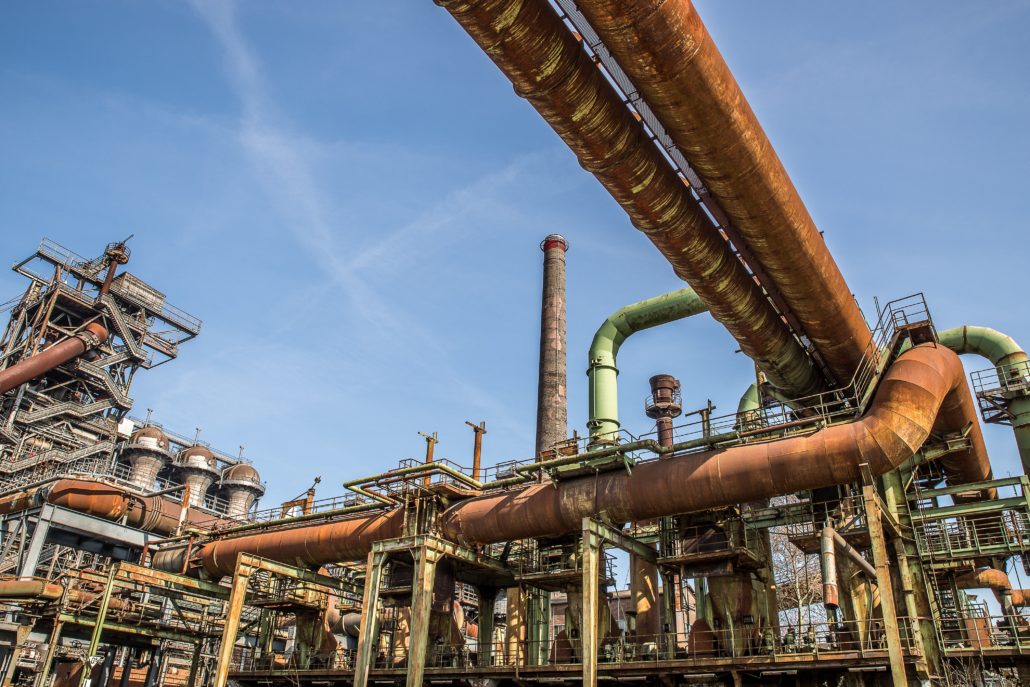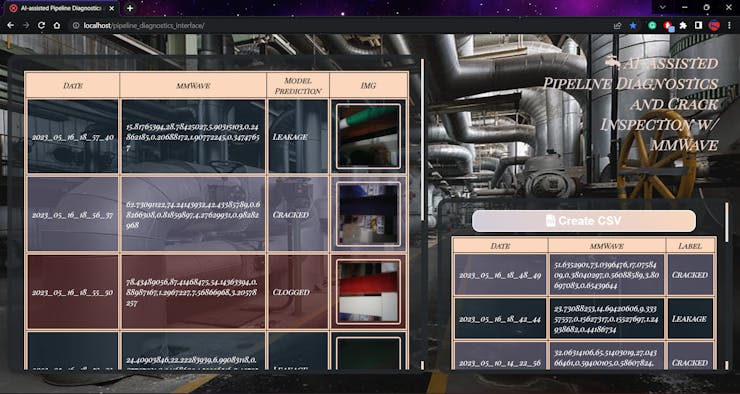AI-Assisted Pipeline Diagnostics and Inspection w/ mmWave Sensor
This AI-assisted pipeline diagnostics and inspection system with mmWave technology provides an efficient and cost-effective solution for detecting pipeline defects. By utilizing a 60GHz mmWave module and Nicla Vision, the system can collect accurate vibration measurements and train a neural network model to identify different pipeline defects. The web application provides an easy-to-use interface for obtaining and displaying the collected data and model detection results with captured images of the deformed pipes. The Dragonite-inspired PCB and liquid-themed case design provide a unique and sturdy solution for field use. Overall, this system can help keep machine operations sustainable and prevent costly manufacturing problems, while providing a non-destructive testing and evaluation mechanism based on vibration characteristics.
Seeed Hardware: Seeed Studio 60GHz mmWave Sensor – Breathing and Heartbeat Module, Arduino Nano R3, LattePanda 3 Delta
Software: Edge Impulse、Arduino IDE
Industry: Industry Maintainance
Background
Maintaining a pipeline system is crucial for ensuring the smooth operation of automated manufacturing processes. A faulty pipeline system can cause various problems, especially for small businesses with limited budgets that cannot afford expensive repairs or replacement costs. Therefore, it is essential to establish an efficient and accurate pipeline diagnostics mechanism that complies with general maintenance regulations. This approach can help technicians maintain machines and prevent companies from wasting resources on replacing or repairing expensive machine components due to the lack of proper pipeline diagnostics. By prioritizing pipeline system maintenance, businesses can extend the durability of their machines beyond expectations and ensure the long-term success of their operations.
Pipeline defects are common while transferring liquids, especially with varying thermal conditions. Mechanical and thermal stress during machine operations causes minute defects in pipelines due to fatigue. When these small defects accumulate, they result in a varying inside turbulent pressure, which leads to slight form (shape) disfigurations. Gradual deficiency over time due to tension is the outcome. In addition to cracks, there are many possible pipeline defects depending on the operation processes and environment, such as corrosion, abrasion, clogged joints due to chemical residue, and leaking connection points due to high gas emissions.

The Challange
Although there are different external pipeline inspection devices utilizing computer vision (camera), magnetic field measurements, and acoustic detection (microphone), these methods cannot be applied interchangeably to different pipeline systems. For instance, a device utilizing object detection with a thermal camera may not be able to detect internal crystals due to high gas permeability in a pipeline system transporting antifreeze to cool components.
The Solution
After reviewing recent research papers on pipeline diagnostics based on vibrations, Kutluhan noticed the lack of appliances that focus on collecting data from a mmWave radar module to extract data parameters, detect potential pipeline defects, and provide real-time detection results with captured images of the deformed pipes for further examination. Therefore, he decided to build a budget-friendly and compact mechanism to diagnose pipeline defects with machine learning. His goal was to assist businesses in keeping their machines durable and stable by eliminating basic pipeline defects.
To collect accurate vibration measurements from a pipeline system and train a neural network model, he built a simple pipeline system that demonstrated three different pipeline defects in each primary section.
He utilized a 60GHz mmWave module to extract data parameters and Arduino Nicla Vision to run his neural network model, capture images of the deformed pipes, and inform the user of the model detection results with the captured pipe images. He connected the mmWave module to Arduino Nano to extract and transmit radar data parameters to Nicla Vision via serial communication and also added four control buttons to Arduino Nano to send commands with collected mmWave data parameters to Nicla Vision, and an ILI9341 TFT LCD screen to display the interface menu.

To develop a full-fledged AIoT device that diagnoses pipeline system defects, a web application was built from scratch. The web application obtained the collected mmWave data parameters with the selected label from Nicla Vision via an HTTP GET request, saved the received information to a MySQL database table, and displayed the stored data records on its interface in descending order. The web application generated a pre-formatted CSV file from the stored data records in the database with a single HTML button on the interface. After completing his data set and building his ANN model with Edge Impulse, Kutluhan deployed and uploaded the model on Nicla Vision as an Arduino library.
He utilized the web application to obtain the model detection results with captured images of the deformed pipes from Nicla Vision via HTTP POST requests, saved the received information to a particular MySQL database table, and displayed the stored model results with the assigned detection images on the application interface in descending order simultaneously. The web application executed a Python script to convert the received raw image buffer to a JPG file automatically before saving it to the server.

To make the device sturdy and compact, He also designed a unique PCB with a Dragonite-inspired PCB design and a liquid-themed case with a sliding front cover and a modular camera holder for Nicla Vision and the 60GHz mmWave radar module. Kutluhan hosted his web application on LattePanda 3 Delta and used a high-quality 8.8″ IPS monitor from Elecrow to display the web application in the field without requiring an additional procedure.

The Results

By applying neural network models trained on pipeline diagnostic classes in detecting pipeline system defects, we can achieve several benefits:
- Keep machine operations sustainable, profitable, and stable by identifying potential pipeline defects before they cause major problems or damage to the equipment. This can lead to increased uptime, productivity, and cost savings.
- Prevent faulty pipeline systems from engendering expensive manufacturing problems by detecting defects early and addressing them promptly. This can prevent costly recalls, rework, and warranty claims, and help maintain a positive brand reputation.
- Assist small businesses with limited budgets in establishing an efficient and accurate pipeline diagnostics mechanism by providing an affordable and accessible solution for detecting pipeline defects. This can level the playing field and enable small businesses to compete with larger enterprises.
- Reduce repair costs of high-value machine components by identifying pipeline defects early and addressing them before they cause significant damage. This can extend the lifespan of the equipment and reduce the need for frequent repairs or replacements.
- provide a non-destructive testing and evaluation (NDT&E) mechanism based on vibration characteristics, which is a safe and reliable way to assess the condition of pipeline systems without causing any damage. This can be especially useful for critical infrastructure systems where safety is a top priority.
More Information
Learn More Project Details on Hackster: AI-assisted Pipeline Diagnostics and Inspection w/ mmWave
Please feel free to reach out to iot@seeed.cc for any inquiries or if you’d like to engage in further project discussions. Your questions and interest are welcomed.
Notes at The End
Millimeter waves (mmWave) represent a cutting-edge segment of the electromagnetic spectrum, occupying frequencies between 30 GHz and 300 GHz. This spectrum is characterized by wavelengths that are in the 10 mm to 1 mm range. What makes mmWave technology stand out is its potential for lightning-fast data transmission, which is essential for the next generation of wireless communication.
At the forefront of mmWave technology advancement, Seeed offers a diverse array of mmWave sensors designed to empower developers in building cutting-edge applications. By merging the capabilities of mmWave with the burgeoning field of tiny Machine Learning (tinyML), Seeed is enabling a new class of AI-powered smart sensors. These innovative devices go beyond simple data transmission; they can interpret and understand the data they collect. This integration transforms mmWave sensors into intelligent tools capable of a multitude of functions such as gesture recognition, object detection, and occupancy sensing, all while operating with remarkable efficiency. Leveraging these sensors, developers can craft intelligent systems that are not only responsive but also adaptive, opening a universe of possibilities in smart home automation, security systems, and beyond.




